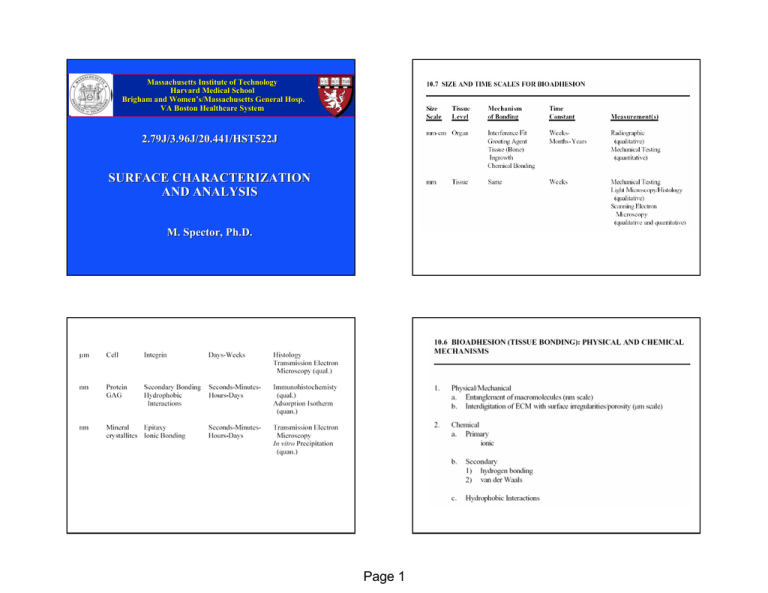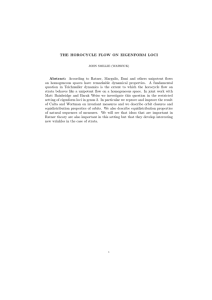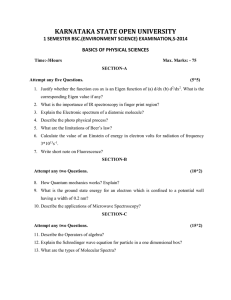Massachusetts Institute of Technology Harvard Medical School Brigham and Women ’
advertisement

Massachusetts Institute of Technology Harvard Medical School Brigham and Women’ Women’s/Massachusetts General Hosp. VA Boston Healthcare System 2.79J/3.96J/20.441/HST522J SURFACE CHARACTERIZATION AND ANALYSIS M. Spector, Ph.D. Page 1 MATERIALS WITH PRIMARY ATOMIC BONDS CHEMICAL BONDING Primary • Metallic • Covalent • Ionic Secondary • van der Waals • Hydrogen • Hydrophobic Interactions e- 100 kcal/mol 200 1010-20 e- e- ee M e- M e- M e e- M eee- Me- M e + 1-2 3-7 1-2 + METALS _ _ + + _ _ + + Metallic (electron “glue” glue” or “cloud” cloud”) -metals -100 kcal/mol Ionic (attraction of positive and negative ions) -ceramics -calcium phosphates -1010-20 kcal/mol H H H H C C C C H H H H Covalent (shared(shared- pair electrons) -polymers -biological macromolec. macromolec. (e.g., e.g., proteins) -200 kcal/mol METAL SURFACE eeM - M Fracture surface e e- ee- M e e M M eeeM e- e M ee- M e e- e- M e-e M e- e- M e e ee- M e- e M e e- M e Page 2 Free surface Electropositive FORMATION OF METALLIC OXIDE O= O= O= e- M e-e M e- e- M e e ee e- M ee- Me- M e ORTHOPAEDIC METALS Stainless Steel Surface CobaltCobaltChromium Titanium METALS FOR TJA: PAST, PRESENT, AND FUTURE ADVANTAGES Strength Ease of manuf. manuf. Availability Strength Rel. Rel. wear resist. Strength Low modulus Corrosion resist. DISADVANTAGES Potential for corrosion High mod. of elasticity High mod. of elasticity Poor wear resistance METALS FOR TJA: PAST, PRESENT, AND FUTURE 190019401970 1980 1990 2000 2010 1900-1940 1940-1960 Stainless Steel CobaltCobalt-Chromium Alloy Titanium Oxinium 190019401970 1980 1990 2000 2010 1900-1940 1940-1960 Stainless Steel CobaltCobalt-Chromium Alloy Titanium Oxinium Selection Criteria Oxinium® Oxinium® (Smith &Nephew Orthopaedics; oxidized zirconium) is the first new metal alloy in orthopaedic surgery in 30 years. Inertness/Biocompatibility Strength Lower Modulus ScratchScratch-resist. Lubricatious NonNon-Allergen. Page 3 Composition of Orthopaedic Metals ORTHOPAEDIC METALS Stainless Steel CobaltCobaltChromium Titanium Oxinium ADVANTAGES Strength Ease of manuf. manuf. Availability Strength Rel. Rel. wear resist. Strength Low modulus Corrosion resist. ScratchScratch-resist. Low modulus DISADVANTAGES Potential for corrosion High mod. of elasticity High mod. of elasticity Nb (2.5%) Poor wear resistance Zr ? Oxinium ASTM B550 How is the Ceramic Surface Produced on Oxinium?: Oxidation Process Co-Cr ALLOY VERSUS Zr-Nb ALLOY: THICKNESS OF THE OXIDE • Wrought zirconium alloy device is heated in air. • Metal transforms as oxide grows; not a coating. • Zirconium Oxide (Zirconia ceramic) is ~5 µm thick. Chromium oxide 0.01 µm CoCo-Cr alloy Air Air Oxygen Oxygen Diffusion Diffusion Airtemp.>500 temp.>500CC Air oo 500 times thicker OriginalSurface Surface Original Ceramic CeramicOxide Oxide Ceramic Zirconium oxide OxygenEnriched Enrichedmetal metal Oxygen Oxinium MetalSubstrate Substrate Metal Metal Figure by MIT OpenCourseWare. G. Hunter, S&N Page 4 ZrZr-Nb alloy 5 µm COMPARISON OF THE OXIDE THICKNESSES ON Co-Cr AND Zr-Nb Chromium Oxide layer 2 µm Typical scratch in the CoCo-Cr surface 0.01 µm thick Co-Cr Alloy Interface between oxide and metal: -no voids -no imperfections Zirconium oxide Zr02 thickness Prof. L.W. Hobbs, MIT Zirconium Oxide layer Cr203 5 µm thick Zr-Nb Alloy Zirconium metal V Benezra, et al. MRS Symp., 1999 Thicker oxide layer (500x thicker) to protect against scratches. Source: Benezra V., M. Spector et al. "Microstructuralinvestigation of the oxide scale on Zr-2.5 Nb and its interface with the alloy substrate." In: Biomedical Materials -- Drug Delivery, Implants and Tissue Engineering. Mat. Res. Soc. Symp. Proc. Vol. 550 , 1999, pp. 337-342. STRENGTH OF Zr OXIDE Transmission Electron Microscopy Transmission Electron Microscopy ADHERENCE OF Zr OXIDE TO THE METAL Zirconium oxide Rectangular crystals of Zr02 POLYMERS “Brick Wall Tough” Polyethylene V Benezra, et al. MRS Symp., 1999 Zirconium metal Polymethylmethacrylate Source: Benezra V., M. Spector et al. "Microstructuralinvestigation of the oxide scale on Zr-2.5 Nb and its interface with the alloy substrate." In: Biomedical Materials -- Drug Delivery, Implants and Tissue Engineering. Mat. Res. Soc. Symp. Proc. Vol. 550 , 1999, pp. 337-342. Source: Benezra V., M. Spector et al. "Microstructuralinvestigation of the oxide scale on Zr-2.5 Nb and its interface with the alloy substrate." In: Page 5 and Tissue Engineering. Mat. Biomedical Materials -- Drug Delivery, Implants H H C C H H H CH3 C C H COOCH3 EFFECT OF GAMMA RADIATION ON PE: OXIDATION ULTRAHIGH MOLECULAR WEIGHT POLYETHYLENE Gamma Radiation H H H H C C C C 1010-30nm H H H H Amorphous Region “Tie” Tie” Molecules O2 H O O2 O2 O2 O2 O2 C C Crystallites H H GAMMA-RADIATION INDUCED MODIFICATION OF POLYETHYLENE Oxidation Aldehyde* from CC-C cleavage Ketone** Ketone** from CC-H cleavage C C O C * Small peak in IR **Large peak in IR Cross-linking Slide removed due to copyright restrictions. "Delamination and White Band: Impact of Gamma Sterilization in Air and Material Consolidation." Sutula et al, AAOS 1995 Orlando O C C C C C C C C from CC-H cleavage Page 6 CHEMICAL BONDING Primary • Metallic • Covalent • Ionic Secondary • van der Waals • Hydrogen • Hydrophobic Interactions 100 kcal/mol 200 1010-20 1-2 3-7 1-2 Page 7 OBJECTIVES OF SURFACE ANALYSIS • Determine how the surface chemistry (and, therefore, properties) differs from the bulk (relative to the function of the material in the device, effects on the body, and response to effects on the body). • Identify contaminants (viz ., with respect to (viz., effects of the material on the body). • Identify chemical bonding possibilities for interactions with molecules in the biological milieu with respect to the effects of the material on the body (viz ., bioadhesion) (viz., bioadhesion) and the body on the material. LIGHT MICROSCOPY Image removed due to copyright restrictions. Comparing visible length scales of unaided human eye, light microscope and electron microscope. Image removed due to copyright restrictions. Diagrams of diascopic and episcopic microscopes. Page 8 LIGHT MICROSCOPY Slide removed due to copyright restrictions. Description and diagram of compound light microscope. LIGHT MICROSCOPY The resolution (lateral) of the light microscope is: D= 0.61l N sin α D = Smallest lateral dimension that can be resolved N = Refractive index of medium surrounding the specimen (i.e ., air, 1.0, or oil, 1.5) (i.e., α = Angular aperture = 1/2 angle of cone of light entering the objective lens from the specimen (depends on the width of the objective lens and distance from the specimen) -- increased by moving lens close to the specimen N sin α = Numerical aperture LIGHT MICROSCOPY N sin α = Numerical aperture For specimens in air viewed by visible light: N = 1.0 λ = 450 nm D = 292 (0.3 µm) For specimens in oil D =200 nm (0.2 µm) For ultraviolet light λ = 200 nm D is approximately 1/2 λ Page 9 Types of Microscopy LIGHT MICROSCOPY Another important parameter is depth of focus: Magnification Depth of Focus 10X 0.1 mm 100X 1 mm 1 2 3 1. Specimen exposed to high vacuum 2. Specimen must have a conducting surface or the use of an “environmental” SEM to prevent “charging” 3. Ultra-thin sections (< 100 nm) are required Slide removed due to copyright restrictions. Schematic diagram of electron microscope. Slide removed due to copyright restrictions. Interaction with Matter: Secondary electrons interact with topography Back scatter electrons interact with composition X-rays interact with chemistry Page 10 SCANNING ELECTRON MICROSCOPY Slide removed due to copyright restrictions. Photos of electron microscope equipment: detectors for secondary and back scatter electrons, and x-rays De-rganified Bone The collagen fibril structure (diameter and periodic pattern) is reflected in the organization of the apatite crystallite structure. 100 nm V. Benezra Rosen, et al., Biomat. 23:921 (2002) Courtesy of Elsevier, Inc., http://www.sciencedirect.com. Used with permission. Bone Mineral; organic matter removed bone - Bio-Oss 100 nm OsteoGraf Synthetic Hydroxyapatites 100 nm 100 nm OsteoGen V. Benezra Rosen, et al. Biomat. 2001;23:921-928 Courtesy of Elsevier, Inc., http://www.sciencedirect.com. Used with permission. T. Orr, et al., Biomat 22:1953 (2001) Courtesy of Elsevier, Inc., http://www.sciencedirect.com. Used with permission Page 11 Lee DD and Glimcher M, J. Mol. Bio. 217:487, 1991 Lee DD and Glimcher M,. Conn. Tiss. Res. 21:247, 1989 TRANSMISION ELECTRON MICROSCOPY OF BONE Images removed due to copyright restrictions. Slide removed due to copyright restrictions. Schematic diagram of transmission electron microscope. M. Spector, J Microscopy 1975;103:55 60 nm Transmission Electron Microscopy bONE Two images removed due to copyright restrictions. See Fig 4b and c in Benezra Rosen, V., et al. Biomat. 23:921 (2002). OsteoGraf/LD300 Anorganic bovine bone Whole bone Transmission Electron Microscopy • Bovine bone from which all the organic matter was removed; anorganic bovine bone; Bio-Oss. • The crystalline architecture is retained even after removing the organic (collagen) template. V. Benezra Rosen, et al., Biomat. 23:921 (2002) V. Benezra Rosen, et al., Biomat. 23:921 (2002) OsteoGen Courtesy of Elsevier, Inc., http://www.sciencedirect.com. Used with permission. Page 12 Scanning Tunneling Microscopy Diffraction Methods • Based on the principle that a monochromatic wave impinging on a regularly arrayed structure (e.g., a crystal) will be diffracted at specific angles only, related to the spacing between the features in the array (e.g., molecules). –The wavelength of radiation needs to be on the order of (or less than) the spacing to be detected. • The diffraction pattern is a unique identifying feature of the material. Schematic diagram removed due to copyright restrictions. “Surf. Prop. of Biomat.” in Biomat. Sci. Eds., B.D. Ratner, et al., Academic Press, San Diego, CA, 1996 X-RAY DIFFRACTION Diffraction from a grating (Left-pointing 1st, 2nd, and 3rd order, and all higher order beams not shown.) 0th Order 1st Order 2nd Order 3rd Order Groove Bragg’s Law n λ = 2d sin θ d= nλ 2 sin θ Incident Plane Wave (Lambda = 2/11 * Grating Pitch) Diffraction Grating Figure by MIT OpenCourseWare. Page 13 n = integer indicating which multiple of the diffracted wave is being considered λ = wavelength of radiation d = spacing between features in the structure (e.g., spacing between molecules in a crystal) θ = the angle between incident and diffracted waves. Width of peaks related to the crystallite size; narrower peak, larger crystallite CRYSTALLOGRAPHIC ANALYSIS (Powder X-ray Diffraction) Sample Photo and pair of graphs (natural bone mineral and synthetic hydroxyapatite) removed due to copyright restrictions. Anorganic Bone Synthetic HA Structural Identification HA: >99.8% Non HA CaCa-P: <0.2%* HA Crystallinity Crystallite Size: Peak Size 88% (002) 39 nm 98% (002) 90 nm * Trace detection of α- and β-TCP, Ca2P2O7 and CaO was observed however insufficient quantity of material existed for confident quantitative assessment. Types of Diffraction START HERE Page 14 OsteoGraf/LD300 New Text Table 1 (Common Methods of Characterizing Biomaterials Surfaces) from Ratner removed due to copyright restrictions. [Preview in Google Books] Anorganic bovine bone Transmission Electron Microscopy V. Benezra Rosen, et al., Biomat. 243:921 (2002) “Surf. Prop. of Biomat.” in Biomat. Sci. Eds., B.D. Ratner, et al., Academic Press, San Diego, CA, 1996 OsteoGen Contact Angle Zisman Plot Contact Angle and Critical Surface Tension Characterize a surface based on its critical surface tension, γsv. At Equilibrium, ∑ surface tensions = 0 γsv-γsl-γlv cos θ = 0 γsv-γsl = γlv cos θ Young's equation Graph from Ratner removed due to copyright restrictions. Cannot solve for γsv because there are 2 unknowns, γsl and γsv The experimental method employed to approximate γsv involves asking the question: What is the surface tension of a liquid that would completely wet the solid surface? “Surf. Prop. of Biomat.” in Biomat. Sci. Eds., B.D. Ratner, et al., Academic Press, San Diego, CA, 1996 Page 15 Contact Angle Assumptions • Equilibrium between the liquid droplet and solid surface has been reached (i.e., no absorption of liquid by the solid and no leaking of substances from the solid). Table 2 (Critical Surface Tension Values for Common Polymers) from Ratner removed – If this assumption cannot be met then the "advancing angle" can be measured to determine the contact angle of the liquid with the dry surface and "receding angle" measured to determine the contact angle with the water absorbed surface. – An alternative method is to measure the underwater (captive-air-bubble) contact angle that an air bubble makes with the immersed surface. This is particularly valuable for measuring surface that can switch from hydrophobic to hydrophilic depending on the environment. due to copyright restrictions. “Surf. Prop. of Biomat.”in Biomat. Sci.Eds., B.D. Ratner, et al., Academic Press, San Diego, CA, 1996 Methods for Measuring the Contact Angle Table 3 (Concerns in Contact Angle Measurement) Figure 5 from Ratner removed due to copyright restrictions. from Ratner removed due to copyright restrictions. “Surf. Prop. of Biomat.”in Biomat. Sci.Eds., B.D. Ratner, et al., Academic Press, San Diego, CA, 1996 “Surf. Prop. of Biomat.” in Biomat. Sci. Eds., B.D. Ratner, et al., Academic Press, San Diego, CA, 1996 Page 16 Auger Electron Spectroscopy • Energy analysis of Auger electrons emitted from a sample. electrons are produced as a result of ionizations in inner core shells under impact of an electron beam. • Significant intensity occurs for Auger electrons emitted with energies up to 2500 eV and these typically have a characteristic range between 1.5 and about 10 atom layers (0.4 to 3 nm). • AES is sensitive to about 1% of most elements except H and He in the outermost atom layer and, generally, some of the atom layers just below the surface. • The excitation is by an electron beam with energies in the range 5 keV to 25 keV. • These beams may be focused to spot sizes of < 12 nm in most modern instruments. SURFACE ANALYSIS Incident Beam • X-Ray – X-Ray Photoelectron Spectroscopy • Electron – Energy Dispersive XX-Ray Microanalysis – Auger Spectroscopy • Ion Beam – Secondary Ion Mass Spectroscopy • Infrared Radiation – Infrared Spectroscopy • • • • • X-ray Photoelectron Spectroscopy Electron Spectroscopy for Chemical Analysis (ESCA) Energy analysis of photoelectrons emitted from a sample generated from core level shells under impact by characteristic X-rays, usually Al or Mg Ka. Photoelectrons have energies up to 1500 eV and typically have a characteristic range between 3 and about 8 atom layers (1 to 3 nm). XPS has a similar sensitivity to AES. It is sensitive to about 1% of most elements except H and He in the outermost atom layer and, generally, some of the atom layers just below the surface. This allows the composition to be determined as a function of depth to 10 nm below the surface, non-destructively. Figure 7 from Ratner removed due to copyright restrictions. Page 17 Electron Spectroscopy for Chemical Analysis, ESCA or X-ray Photoelectron Spectroscopy, XPS ESCA or XPS Figure 8 from Ratner removed due to copyright restrictions. Figure 7 from Ratner removed due to copyright restrictions. Figure 6 from Ratner removed due to copyright restrictions. “Surf. Prop. of Biomat.” in Biomat. Sci. Eds., B.D. Ratner, et al., Academic Press, San Diego, CA, 1996 “Surf. Prop. of Biomat.” in Biomat. Sci. Eds., B.D. Ratner, et al., Academic Press, San Diego, CA, 1996 4 C peaks: hydrocarbon, C singly bonded to O, C in amide-like environment, and C in acid or ester environments SURFACE AND BULK ANALYSIS Figure 9 from Ratner removed due to copyright restrictions. Sample Analysis Ca/P for§ for§ Ca P O C Ratio:† Ratio:† Anorganic Bulk: 27 16 57 – Bulk: 1.69 Bone Surface: 19 13 58 10 Surface: 1.46 Synthetic Bulk: 25 15 60 – Bulk: 1.67 20 13 58 9 Surface: 1.54 Hydroxyapatite Surface: Composition § : Analysis for: for: Bulk Composition: Energy Dispersive XX-ray Analysis (0(0-2 µm sampling depth) Surface Composition: Electron Spectroscopy for Chemical Analysis (0(0-5 nm sampling depth). † : The stoichiometric ratio of Ca/P for Hydroxyapatite (Ca10(PO4)6(OH)2) is 1.67. “Surf. Prop. of Biomat.” in Biomat. Sci. Eds., B.D. Ratner, et al., Academic Press, San Diego, CA, 1996 Page 18 Infrared Spectroscopy Attenuated Total Reflectance Mode Static Secondary Ion Mass Spectrometry • Mass analysis of positive or negative ions emitted from samples under impact of an energetic ion beam. • Significant intensity can occur for ions with masses up to and beyond 1000 a.m.u. that originate mainly from the outermost molecular layer. • The fragments observed in the spectrum reflect the precise molecular groups on the surface. • This allows distinction and identification not possible by AES and XPS but only where suitable reference spectra are available. • SSIMS has a very much higher sensitivity than AES or XPS, but quantification is much more complex since matrix effects are dominant. Figure 11 A from Ratner removed due to copyright restrictions. “Surf. Prop. of Biomat.” in Biomat. Sci. Eds., B.D. Ratner, et al., Academic Press, San Diego, CA, 1996 Infrared Spectroscopy External Reflectance Mode Infrared Spectroscopy Diffuse Reflectance Mode Figure 11 C from Ratner removed due to copyright restrictions. Figure 11 B from Ratner removed due to copyright restrictions. “Surf. Prop. of Biomat.” in Biomat. Sci. Eds., B.D. Ratner, et al., Academic Press, San Diego, CA, 1996 “Surf. Prop. of Biomat.” in Biomat. Sci. Eds., B.D. Ratner, et al., Academic Press, San Diego, CA, 1996 Page 19 MIT OpenCourseWare http://ocw.mit.edu 20.441J / 2.79J / 3.96J / HST.522J Biomaterials-Tissue Interactions Fall 2009 For information about citing these materials or our Terms of Use, visit: http://ocw.mit.edu/term




